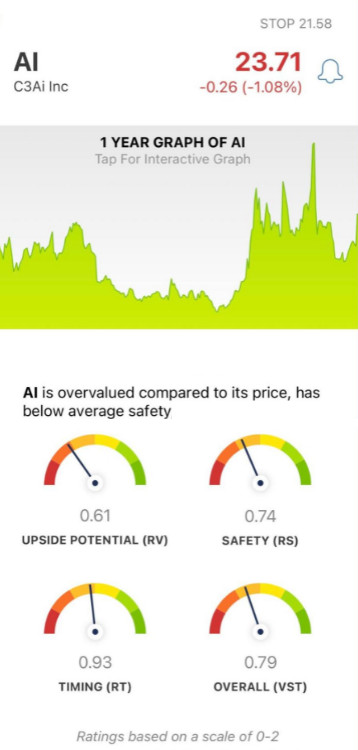When selecting a platform that makes use of AI to forecast or analyze stocks Customer support is a crucial aspect. Support that is prompt and reliable will make all the difference when it comes time to resolve issues, maximize utilization of the platform, create an efficient trading environment and more. Here are ten top suggestions for evaluating the support provided by these platforms.
1. Examine the availability of support
24/7 support: Make sure that your platform is available round the clock, which is important for trading in real-time and global markets.
Business hours: If there is no 24/7 support it is important to ensure that support is available at the time you need it.
Check for holiday coverage.
2. Test Response Times
Initial response. Send an initial test question to support to see how fast they'll be able to respond.
Resolution time: Decide how long you have to deal with problems before they can be solved, and don't simply admit their existence.
Live chat Live chat: If live chat is enabled Test its effectiveness and responsiveness.
3. Assess the support channels
Multiple channels: Ensure that the platform has assistance in various channels (e.g. phone and email, live chat and social media).
The preferred channel: Make sure that your preferred support channel (e.g. telephone, chat) is accessible and reliable.
Self-service solutions: To speed up problem solving, look for complete information bases, FAQs and community forums.
4. Assess Support Quality
Support agents must be well-informed about trading platforms, technical issues and platforms.
Problem-solving: Determine whether agents can effectively resolve complex issues or escalate them if appropriate.
Professionalism - Examine the support interactions are pleasant, helpful and professional.
5. Look for Account Managers
Support Premium: Verify if the institutional user or plans with higher tiers are able to access account managers.
See whether the account manager can provide tailored support, proactive guidance and help with a proactive approach.
Relationship building: Make sure the account managers are on hand and establish long-term relationships.
Review the Support Documentation
Knowledge base - Make sure that the platform has searchable and well-organized knowledge base with tutorials. Guides, and suggestions for troubleshooting.
Video tutorials: See if the platform offers webinars or video tutorials for those who prefer visual learning.
API documentation. API documentation is important for developers.
7. Evaluation of Peer and Community Support
Forums for users. Find out if your platform has an active forum or a user community where you can find tips and techniques.
Social media groups - Search for non-official Facebook, LinkedIn, Reddit and other social media sites in which users debate the platforms.
Community engagement: Determine whether team members are active participants in forums or discussions in the community.
8. Evaluate Escalation Processes
Issue escalation - Ensure that there's a clearly defined procedure for elevating unresolved concerns to higher management or support levels.
Follow-up. Make sure whether support is following up when the issue is resolved.
Feedback loop: Verify that the platform is collecting user feedback to improve support services.
9. Test Support for Critical Situations
Contact customer support during times of high-volatility and find out how they react.
Issues with technical aspects: You can simulate a technical problem (e.g. login problems, data differences) to see the response of our support team.
Trade execution - Verify that support is available for urgent trade issues (e.g. orders that are not executed, delays in execution).
Take a look at the feedback of users
Online reviews: Check out the reviews of customers on platforms such as copyright or G2 to gauge about the overall level of satisfaction with the customer service.
Seek out positive testimonials or case study highlighting the support experience.
Complaints: Check how the platform handles complaints and negative feedback regarding support.
Bonus Tips
Support for the trial period: To evaluate the quality of the system, you are able to test its support for a trial period of no cost.
Language support: Check whether you are able to get help in your native language if you don't know English.
Onboarding and training Learn whether there are any onboarding sessions that can assist new users in getting up and running.
These tips will help you examine the customer support of AI stock-predicting/analyzing trading platforms. This way, you'll be able to choose a platform with reliable prompt and friendly assistance. A strong customer service will improve your experience, and you can make the most of all the options. Take a look at the top rated ai copyright signals for blog advice including trader ai intal, ai trader, ai for investing, ai copyright trading, ai trading app, trader ai intal, investment ai, ai chart analysis, ai stock trader, ai stock picker and more.

Top 10 Tips To Evaluate The Speed And Latency Of Ai Stock Prediction/Analyzing Trading Platforms
The speed and the latency of a trading platform is a crucial factor to be considered, especially when it comes to active traders as well as high-frequency investors and algorithmic traders. Milliseconds delay could affect trade execution. Here are 10 suggestions to determine the speed and latencies of these platforms.
1. Real-Time data feeds can be used to determine the quality of your real-time data
Data delivery time: The platform must provide real-time, accurate data within the shortest amount of time (e.g. with sub-millisecond delay).
Closeness of data source: Determine the location of servers close to major exchanges.
Data compression: Determine whether your platform is using efficient data compression techniques to speed up data delivery.
2. Test Trade Speed of Execution
Order processing time is the time that your order will be processed and executed through the platform.
Direct Market Access (DMA) Check to see if your platform supports DMA. This allows orders to go directly to the exchange, without the necessity for intermediaries.
Execution Reports: Check if your platform provides complete reports on the completion of orders, with timestamps.
3. Examine the Platform's Responsiveness
User interface (UI) speed: See how fast the UI on your platform responds to your inputs (e.g. pressing buttons or loading charts).
Updates to charts - Check that your charts are up-to-date in real time and without any delays.
Mobile app performance: If you are using a mobile application, ensure it performs as quickly as the desktop version.
4. Look for networks with low-latency infrastructure.
Server Locations: Check whether the server used by the platform is that have low latency, located close to major hubs for financial exchanges or financial hubs.
Co-location service: Find out whether your platform has this option. This allows you to host trading algorithm on servers near to the exchange.
High-speed Networks: Confirm the application's use of high-speed, fiber-optic network or other technologies that have low latency.
5. Backtesting the simulation speed and test backtesting
Historical data processing: Test how fast the platform processes and analyzes the historical data to backtest.
The latency of the platform should be low enough to allow for real-time simulations of trades.
Parallel processing (or distributed computing): Find out whether a platform makes use of the concept of parallel processing or distributed processing in order to speed up the complexity of calculations.
6. Estimate API Latency
API response time: This is the speed at which an API platform responds to requests.
Rate limits. Check to see what limits are appropriate for the API. This can aid in preventing delays during high-frequency transactions.
WebSocket Support: Determine if the platform supports WebSocket protocols that stream data in real time and with low latency.
7. Test Platform Stability with Load
Simulation of scenarios involving high volume trading to determine if the platform is reliable and stable.
Test your platform in periods of market volatility.
Check to see whether there are any tools that allow you to test strategies for extreme circumstances.
8. Evaluation of Network and Connectivity
Internet speed requirements: Make sure that your connection is at the recommended platform speed.
Redundant Connections: To minimize interruptions, make sure that your platform supports redundant internet connections.
VPN latency If you are using a VPN for connection, be sure it doesn't introduce significant latency. Also, make sure the provider offers alternative options.
9. Check for Speed Optimization Features
Pre-trade analytics: Ensure the platform provides pre-trade analytics to optimize the routing of orders and speed of execution.
Smart order routing (SOR) Find out that the platform is using SOR to identify the fastest and cost-effective execution sites.
Monitoring latency: Verify if the platform provides tools to monitor and analyze latency in real-time.
Review User Feedback & Benchmarks
Feedback from users: Use reviews from users to assess the platform's performance in terms of the speed of its operation and latency.
Benchmarks from third parties: Search for independent reviews or benchmarks that compare the performance of the platform versus the speed of its rivals.
Case studies and testimonials: Find out whether there are any case studies that demonstrate the effectiveness of the platform's low-latency capabilities.
Bonus Tips
Trial period: Try out an unpaid test or demo of the platform to check out how it performs in real scenarios.
Customer support - Check if there is support available for issues relating to latency, optimization, or other issues.
Hardware requirements: Verify whether the platform requires special hardware (e.g. high-performance PCs) to achieve optimal speed.
Use these guidelines to assess the speed and latency for AI stock predicting/analyzing platforms. Choose a platform that suits your trading needs, and reduces the amount of the time it takes to complete transactions. The ability to operate with low latency, especially in high frequency and algorithmic trading, is crucial. Even small delays can significantly affect profit. Check out the most popular more about free ai tool for stock market india for website examples including ai for investing, best ai stocks to invest in, best ai for trading, trading ai bot, ai trading software, ai stocks to invest in, investing in ai stocks, ai bots for trading, ai for copyright trading, ai stock trading app and more.
